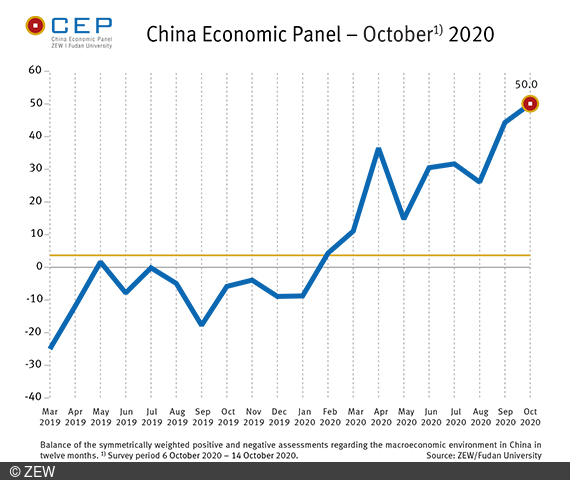Outlook for Chinese Economy Remains Very Positive
China Economic PanelCEP Indicator Rises to 50.0 Points
In the October survey (6–14 October 2020), the CEP indicator rose by 5.6 points to a new level of 50.0 points. This marks a new record high of the indicator since the survey began in mid-2013. Although the increase is slightly lower than in the previous month, when the indicator jumped by 18.3 points, optimism regarding the Chinese economy is still growing quite strongly. The CEP indicator, based on the China Economic Panel (CEP) in cooperation with Fudan University, Shanghai, reflects the economic expectations of international financial market experts for China on a 12-month basis.
The assessment of the current economic situation also continues to improve, with the corresponding indicator currently standing at 5.9 points, 4.0 points higher than in September. “It is striking that by now 84 per cent of the experts assume that the economy will improve either slightly or even strongly. In the previous month, this figure was still at just under 70 per cent,” says Dr. Michael Schröder, researcher in the “International Finance and Financial Management” Research Department at ZEW Mannheim.
Pre-COVID-19 growth path not before 2022
However, experts no longer expect the economy to improve as strongly as they still thought in September 2020. The growth forecast for real gross domestic product (GDP) for the current year is 1.9 per cent, compared with 2.7 per cent in the previous month. The forecast for 2021 has also been revised downwards by one percentage point from 5.7 per cent (September survey) to currently 4.7 per cent. “Although this would still be a great success for the country hit by the coronavirus crisis, growth of 4.7 per cent would be well below the level of six to 6.7 per cent that China is normally used to. According to the experts, the pre-COVID-19 growth path will therefore not be reached again until 2022,” Michael Schröder explains.
Growth expectations for Shenzhen increase at the expense of Hong Kong
With regard to the expectations for the development of the most important economic regions, it is striking that the figures for Hong Kong remain strongly in negative territory at minus 36.9 points. In contrast, growth expectations for the city and region of Shenzhen, which is located on the mainland opposite Hong Kong, are at 39.5 points, an increase of 7.7 points compared to the previous month. “The experts apparently assume that the Chinese government will continue to promote Shenzhen as southern China’s economic hub at the expense of Hong Kong,” says Schröder.

